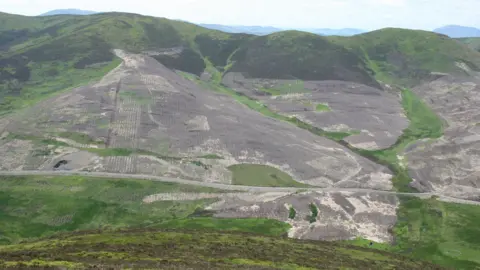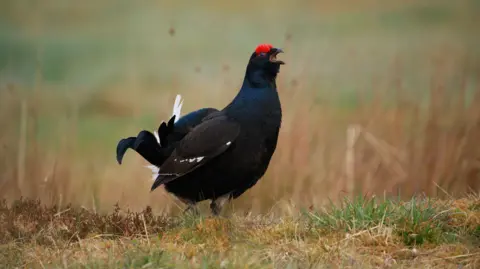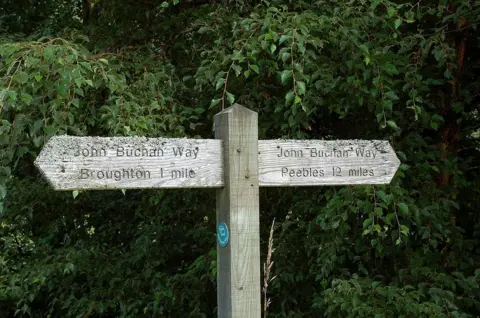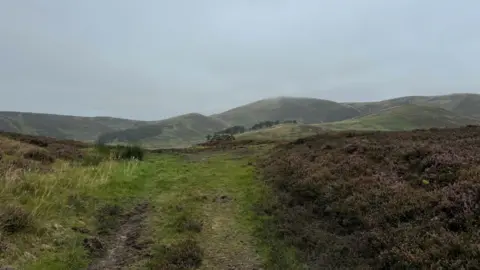Legal challenge halts £2m forest on black grouse moorlands
 Stobo Residents Action Group
Stobo Residents Action GroupA campaign group has forced the planting of a commercial forest on black grouse moorlands in the Scottish Borders to be halted.
A legal challenge by Stobo Residents Action Group (SRAG) against the government-backed woodland creation scheme in Peeblesshire has led to operations being stopped this week.
If a review by Scottish Forestry sides with the protesters, thousands of recently planted trees could be uprooted to allow for the hillsides to be restored.
David Lintott from SRAG said: "What's happened at Stobo Hope is very upsetting - this is devastating for the flora and fauna."
 Affric Highlands/PA Wire
Affric Highlands/PA WireThe Forestry Carbon Sequestration Fund, which is managed by the Guernsey-based investment company True North, was awarded more than £2million from the government's forestry grant scheme for creating a woodland in the rural valley.
Their proposals for a mix of commercial and native tree planting across 10 square-kilometres of the area to the north of Peebles was approved by Scottish Forestry in February.
But locals formed an action group to fight the decision as they believed the hills not only provided valuable habitats for rare species of wildlife, but were also within a designated National Scenic Area.
Mr Lintott said: "Nature Scot and the RSPB both raised concerns, as well as ourselves, yet Scottish Forestry allowed this to go ahead without an environmental impact assessment.
"Thousands of people walk in these hills every year and they provide habitats for many species.
"We don't believe that public money should be supporting a woodland that would cause so much harm."
Protesters claim that up to 400 hectares of the hillsides have already been sprayed with herbicides.
The heather-covered moorlands had been home to black grouse, golden eagles and other protected species.
A three-mile stretch of the popular John Buchan Way walking trail also passes through the land.
"We will now have to wait on Scottish Forestry's review, but we firmly believe that when all concerns are taken into account this should not be allowed to progress, and the moorland restored to its original condition," added Mr Lintott.
 Jim Barton
Jim BartonThe Court of Session approved SRAG's petition calling for the consideration of a full environmental impact assessment to be a requirement of the Stobo Hope plantation.
During last month's judicial review in the Court of Session it was revealed that blanket spraying had taken place on around 400 hectares of the valley.
This week, Scottish Forestry issued True North with an immediate stop notice.
They will now review their original screening decision, which led to the original permission being granted, to see if a full forestry environmental impact assessment is required.
Director Brendan Callaghan said: “As with all woodland creation applications that are submitted to us, we need to have all the relevant information available in order to make informed decisions.
“Unfortunately with the Stobo application, a material piece of information was not disclosed by the applicant as we started the screening process, where we review the likely environmental effects of the project.
“In this case we should have been notified of large-scale overall herbicide spraying prior to the application being submitted, so that we could take it into account when we were assessing the project, but in this case we were not informed.
“Consequently, Scottish Forestry have taken enforcement action to stop the developer’s work at Stobo so that the woodland creation application and the new information can be reassessed."
 Scottish Forestry
Scottish ForestryNo timescales have yet been put on the Scottish Forestry review.
The investment company behind the woodland believe they acted lawfully throughout the screening process.
Harry Humble, CEO of True North, said: “We are dismayed that we have been asked to stop work.
"Over the course of three years, we have gone through an extensive, diligent and responsible design and consultation process.
“We have worked extremely hard to design an environmentally and ecologically sound mixed forest, from a third of the site being retained as open space and 130 hectares planted with native trees to 140 hectares planned specifically to favour black grouse.”
